An emergency room visit is never a pleasant affair. However, being prepared and knowing what to expect can help alleviate some of the stress of the experience. Read on to find out what you should bring with you and what to anticipate during the wait and in the treatment room.
Never Miss a Beat!
Subscribe to Our HealthBeat Newsletter!
Thank you for subscribing!
You can now select the specific newsletters you'd like to receive.
You are already subscribed.
Subscribe to more newsletters in our email preference center.
Sorry, an error occurred. Please try again later.
Get Healthy Tips Sent to Your Phone!
What to Bring With You to the Emergency Room
If you have not arrived by ambulance, the first person you will talk to is the registrar. To keep your personal information private, the registrar will have you fill out a form with your:
- Legal name.
- Date of birth.
- Last four numbers of your Social Security number.
- Reason for your visit.
- Name of your primary care provider (PCP).
This information will allow the registrar to enter your data into the hospital’s computer system.
Other information needed, such as emergency contacts and insurance information, will be collected after you have been seen by a health care team member.
While You Wait in the Emergency Room
While the goal is to see every patient as soon as possible, patients who require more care, or are seriously ill or injured, are always treated first even though they may have arrived at the Emergency Department (ED) after you.
There may be other reasons for delays. Your ED health care team may:
- Need time to learn your medical history.
- Be trying to get in touch with your PCP.
- Be waiting for the results of blood tests, x-rays, or specialized procedures.
If you start to feel worse while you are waiting, alert a nurse immediately.
Some additional things to consider:
- Eating or Drinking – Please do not eat or drink unless you ask the staff if it is OK. It is important not to eat or drink anything in case you need a procedure or test that requires an empty stomach.
- Restroom Assistance – If you need any help, don’t hesitate to ask a staff member to escort you. Before using the restroom, please ask a health care team member if a urine or stool sample is needed to assist in your diagnosis.
- Home Medicines/Allergies – Please give a list of home medicines, herbal supplements, and allergies to your health care team members so that they can ensure your safety and prevent interactions with any medicines you may be given during your stay.
- Special Needs – If you or a loved one have any special needs, please let staff know so that they can get the right health care team member involved.
In the Treatment Room
After your basic registration is complete, you will be taken to a treatment space, unless the department is full. If the ED is full, you will be seen by a triage nurse. The triage nurse will ask you the reason for your visit and about any allergies. The nurse also will take your vital signs, such as your:
- Temperature.
- Blood pressure.
- Pulse.
- Pulse oximetry (oxygen) level.
Triage nurses are specially trained to identify patients who may come into the ED with life-threatening conditions. At times, it may be necessary for a patient who arrives after you to be taken care of before you. After the triage process is complete, you may be asked to wait in the waiting room if the department is full and your condition is deemed nonlife-threatening. If you are placed in the waiting room after triage, a staff member will come for you as soon as a room is available. Please remain seated in the waiting room until you are called.
Examination and Testing
Once you are in a treatment space, you will most likely be asked to change into a hospital gown. You will be assigned a nurse who will get your medical history, along with other information.
You will be seen by the first available health care team member (ED doctor, resident, or nonphysician advanced practice provider under the direction of a physician) who will examine you and order testing if necessary. These tests may include:
- Electrocardiogram (EKG) and/or continuous cardiac monitoring.
- Blood work.
- Urine testing.
- Radiological studies — x-rays, CT scans.
- IVs and/or medicines.
Some tests may happen at your bedside. At other times, you may need to be moved to a different department for testing. Most test results take about an hour.
For some tests, such as enhanced CT scans, you may need to drink something known as oral contrast to prepare for the scan. Many patients say it tastes like a very sweet, carbonated beverage. The oral contrast allows for better visualization and more accurate test results.
Diagnosis
Once the ED doctor has all your test results, a decision will be made about whether you need to stay in the hospital or if you can safety leave the hospital.
Editor's Note: This article was originally published on , and was last reviewed on .
About UPMC
Headquartered in Pittsburgh, UPMC is a world-renowned health care provider and insurer. We operate 40 hospitals and 800 doctors’ offices and outpatient centers, with locations throughout Pennsylvania, Maryland, New York, West Virginia, and internationally. We employ 4,900 physicians, and we are leaders in clinical care, groundbreaking research, and treatment breakthroughs. U.S. News & World Report consistently ranks UPMC Presbyterian Shadyside as one of the nation’s best hospitals in many specialties.
